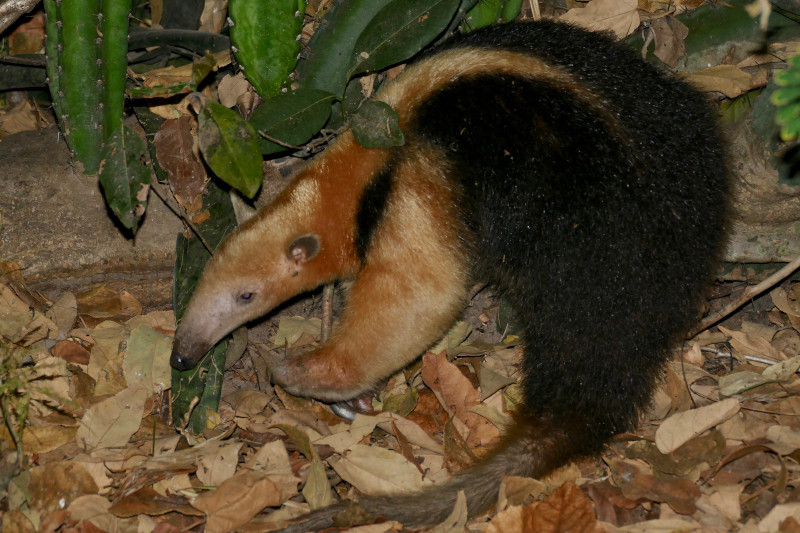Southern Tamandua Facts
- Individuals who know of this fascinating creature most often refer to it by the common name of the Southern Tamandua. Yet it also has several other, less often used, names. These alternate terms include that of the lesser anteater and the collared anteater.
- Among professional researchers, however, the remarkable mammal goes by yet another term, its scientific name. That, though, remains somewhat hard to pronounce. That’s because the official name for the animal is a rather tongue-twisting term.
- Regardless of whether one refers to it by the technical name of Tamandua tetradactyla, or one of the common terms, though, one fact remains paramount. That’s the undeniable fact that, to those who appreciate Nature, it’s an interesting species.
- The first known recognition of this remarkable work of evolution as a separate and distinct species also took place in the year 1758. This scientifically noteworthy action further took place due to the efforts of the Swedish researcher, Carl Linnaeus.
- For the moment, the Southern Tamandua seems to be maintaining a relatively stable, if scattered, population base. This further appears to hold true throughout the entirety of its range. The IUCN, therefore, currently lists it as Least Concern on its Red List.
- It does face its share of threats, of course. In the short term, it’s endangered by hunters, who kill the creature, claiming it kills their dogs. Local people also kill them, to make rope from the tendons in their tail. And of course, climate change now threatens it.
Related Articles
Southern Tamandua Physical Description
Among its many relatives, collectively known as anteaters, the Southern Tamandua ranks as a roughly medium-sized species, overall. Exact physical size also varies quite significantly, between individuals. This principlly occurs due to their environmental factors.
The animal does not, however, exhibit any noticeable degree of the physiological trait of sexual dimorphism. Due to this, individuals of both genders range in head and body length from 13 – 35 in (34 – 88 cm). Its prehensile tail adds another 15 – 26 in (37 – 67 cm).
The weights of mature adults also varies significantly, and again does so regardless of gender. Fully grown adults of either sex, therefore, range in weight from 3.3 – 18.5 lb (1.5 – 8.4 kg). Though not unknown, such extreme variation in size remains fairly uncommon.
Its snout doubtless qualifies as its most noticeable feature, much like its relatives. This develops as highly elongated, thin, and tapering toward the end. It also has 4 claws on its front feet, but five on the rear feet. The tip and underside of the tail develop hairless.
The fascinating mammal possesses yet one more trait to amaze those who learn of it. Uniquely, the basic coloring of the Southern Tamandua also varies within its territorial range. This trait further distinguishes it from the majority, though not all, of other mammals.
That’s because individuals in one part of its range develop as almost entirely blonde in color. Those in another region, meanwhile, may be either brown, blonde or black. But in the other portion of the mammals’ natural range, specimens display tan, brown, and blonde.
- Kingdom: Animalia
- Phylum: Chordata
- Class: Mammalia
- Order: Pilosa
- Family: Mermicophagidae
- Genus: Tamandua
- Species: T. tetradactyla
Southern Tamandua Distribution, Range, and Habitat
Though its population groupings appear in scattered concentrations, it has one advantage. That’s due to the fact that it evolved as native to a relatively large portion of the globe. That endemic territorial range includes the majority of the continent of South America.
The remarkabale creature also inhabits the island of Trinidad. Wherever it makes its home, however, it displays decided preferences in its choice of habitat. Fortunately, Nature evolved it into a highly versatile species, capable of existing in several types of habitat.
As a result of this respectable, and beneficial, versatility, individuals and groups appear throughout the entire region. The intrepid animal makes it home in regions of both dry and wet forests. This includes tropical rainforest, savanna, and even areas of thorn scrub.
It further manifests a remarkably strong preference for areas near rivers and streams. There, it especially likes a strong presence of air plants and vines. Experts additionally believe this to be because much of its natural prey also prefers this particular type of habitat.
It’s primarily a solitary creature, in addition to being mainly nocturnal in its habits. It will, however, occasionally display daytime activities. It mainly builds a nest in the trunks of hollow trees, or, on occasion, burrows of other animals that have been abandoned.
The Southern Tamandua also lives a primarily arboreal life, and becomes quite clumsy on the ground. The diet of the animal consists almost entirely of termites and ants. Individuals do, however, occasionally supplement this with relatively small amounts of fruit.
Species Sharing Its Range
Check out our other articles on 6 Captivating European Caves, Chinese Giant Salamander, Namib Desert, Dwarf Crested Iris, Reef Manta Ray, Claudina Butterfly, Anegada ground iguana

